Development and Application of a Vehicle-Mounted Soil Texture Detector
Abstract
1. Introduction
2. Materials and Methods
2.1. Soil Texture Prediction Method
2.2. Soil EC Measurement Principle
- —Calculated soil EC (μS/cm)
- , , , —The distance between the probes (cm)
- —Constant current source current (A)
- —Voltage between M and N probes (V)
2.3. Principles of Soil Surface Image Analysis
- P—Image
- (i,j)—Pixel coordinates
- P—Image
- (i,j)—Pixel coordinates
- P—Image
- (i,j)—Pixel coordinates
2.4. Detector Design
2.5. Soil Samples and Experimental Preparation
3. Results
3.1. Electrical Conductivity and Texture Features
3.2. Analysis of Soil EC Measurement Results
3.3. Analysis of Soil Texture Measurement Results
4. Discussion
5. Conclusions
- Based on the feasibility analysis of the texture measurement principle, the soil EC is combined with the machine vision device, and the SVM model is used as the embedded model to obtain and analyze the in-situ texture information of farmland soil in real time. Compare the results obtained by this method with the standard method data. The results show that this method of obtaining in-situ texture information of farmland soil does not require chemical reagents, long test time, and artificial energy, and it is a new method to quickly obtain soil texture in real time.
- The correlation analysis between the farmland measurement results of the in-situ vehicle-mounted soil texture detector and the results obtained by the laboratory standard method is carried out, and the correlation analysis result R2 of the soil EC measurement is 0.75. The accuracy rate of soil texture prediction data obtained by combining EC and GLCM using the embedded model reached 84.86%. The results show that the vehicle-mounted soil texture detector combined with EC and GLCM can predict the soil texture of the target plot based on the original information of the farmland, and has high accuracy.
Author Contributions
Funding
Acknowledgments
Conflicts of Interest
References
- Meng, C.; Yang, W.; Zhang, M.; Han, Y.; Li, M.Z. Development of Real-time Measurement System for Vehicle mounted Soil Conductivity and Mechanical Resistance. Trans. Chin. Soc. Agric. Mach. 2019, 50, 102–107. [Google Scholar] [CrossRef]
- Li, H.R.; Liu, B.; Wang, R.X.; Liu, W.; Fang, Y.; Yang, D.L. Particle-size Distribution Affected by Testing Method. J. Desert Res. 2018, 38, 619–627. [Google Scholar] [CrossRef]
- Wang, W.P.; Liu, J.L.; Zhang, J.B.; Li, X.P. Evaluation and correction of measurement using diffraction method for soil particle size distribution. Trans. Chin. Soc. Agric. Eng. 2014, 30, 163–169. [Google Scholar] [CrossRef]
- Faé, G.S. Making Soil Particle Size Analysis by Laser Diffraction Compatible with Standard Soil Texture Determination Methods. Soil Sci. Soc. Am. J. 2019, 83, 124. [Google Scholar] [CrossRef]
- Zhu, Y.; Zhang, Z.D.; Liu, C.; Zhang, X. Comparison of Laser Diffraction Method and Pipette Method on Soil Particle Size Distribution Determination—A Case Study of Variously Degraded Kastanozem. Res. Soil Water Conserv. 2018, 25, 62–67. [Google Scholar] [CrossRef]
- Vos, C.; Don, A.; Prietz, R. Field-based soil-texture estimates could replace laboratory analysis. Geoderma 2016, 267, 215–219. [Google Scholar] [CrossRef]
- Hobley, E.U.; Prater, I. Estimating soil texture from vis–NIR spectra. Eur. J. Soil Sci. 2019, 70, 83–95. [Google Scholar] [CrossRef]
- Jović, B.; Ćirić, V.; Kovačević, M.; Šeremešić, S.; Kordić, B. Empirical equation for preliminary assessment of soil texture. Spectrochim. Acta Part A Mol. Biomol. Spectrosc. 2019, 206, 506–511. [Google Scholar] [CrossRef]
- Wu, W.; Yang, Q.; Lv, J.; Li, A.; Liu, H. Investigation of Remote Sensing Imageries for Identifying Soil Texture Classes Using Classification Methods. IEEE Trans. Geosci. Remote Sens. 2019, 57, 1653–1663. [Google Scholar] [CrossRef]
- Castaldi, F.; Palombo, A.; Santini, F.; Pascucci, S.; Pignatti, S.; Casa, R. Evaluation of the potential of the current and forthcoming multispectral and hyperspectral imagers to estimate soil texture and organic carbon. Remote Sens. Environ. 2016, 179, 54–65. [Google Scholar] [CrossRef]
- Zhai, Y.; Thomasson, J.A.; Boggess, J.E.; Sui, R. Soil texture classification with artificial neural networks operating on remote sensing data. Comput. Electron. Agric. 2006, 54, 53–68. [Google Scholar] [CrossRef]
- Dematte, J.A.M.; Fiorio, P.R.; Ben-Dor, E. Estimation of Soil Properties by Orbital and Laboratory Reflectance Means and its Relation with Soil Classification. Open Remote Sens. J. 2009, 2, 12–23. [Google Scholar] [CrossRef]
- Odeh, I.O.A.; McBratney, A.B. Using AVHRR images for spatial prediction of clay content in the lower Namoi Valley of eastern Australia. Geoderma 2000, 97, 237–254. [Google Scholar] [CrossRef]
- Wu, J.; Li, Z.; Gao, Z.; Wang, B.; Bai, L.; Sun, B. Degraded land detection by soil particle composition derived from multispectral remote sensing data in the Otindag Sandy Lands of China. Geoderma 2015, 241, 97–106. [Google Scholar] [CrossRef]
- Castaldi, F.; Casa, R.; Castrignanò, A.; Pascucci, S.; Palombo, A.; Pignatti, S. Estimation of soil properties at the field scale from satellite data: A comparison between spatial and non-spatial techniques. Eur. J. Soil Sci. 2014, 65, 842–851. [Google Scholar] [CrossRef]
- Li, M.; Sasao, A.; Shibusawa, S. Local variability of soil nutrient parameters in japanese small size field. J. Jsam 2010, 61, 141–147. [Google Scholar] [CrossRef]
- Heil, K.; Schmidhalter, U. Characterisation of soil texture variability using the apparent soil electrical conductivity at a highly variable site. Comput. Geosci. 2012, 39, 98–110. [Google Scholar] [CrossRef]
- Jia, S.; Li, H.; Wang, Y.; Tong, R.; Li, Q. Hyperspectral Imaging Analysis for the Classification of Soil Types and the Determination of Soil Total Nitrogen. Sensors 2017, 17, 2252. [Google Scholar] [CrossRef]
- De Oliveira Morais, P.A.; de Souza, D.M.; de Melo Carvalho, M.T.; Madari, B.E.; de Oliveira, A.E. Predicting soil texture using image analysis. Microchem. J. 2019, 146, 455–463. [Google Scholar] [CrossRef]
- Fisher, P.; Aumann, C.; Chia, K.; O’Halloran, N.; Chandra, S. Adequacy of laser diffraction for soil particle size analysis. PLoS ONE 2017, 12, e0176510. [Google Scholar] [CrossRef]
- Andrenelli, M.C.; Fiori, V.; Pellegrini, S. Soil particle-size analysis up to 250 μm by X-ray granulometer: Device set-up and regressions for data conversion into pipette-equivalent values. Geoderma 2013, 192, 380–393. [Google Scholar] [CrossRef]
- Kitchen, N.R.; Sudduth, K.A.; Drummond, S.T. Soil Electrical Conductivity as a Crop Productivity Measure for Claypan Soils. J. Prod. Agric. 1999, 12, 607–617. [Google Scholar] [CrossRef]
- Si, C.; Kai, Z.; Tao, J.; Xiaofeng, L.; Xingming, Z.; Xiangkun, W. Predicting Surface Roughness and Moisture of Bare Soils Using Multi-band Spectral Reflectance Under Field Conditions. Chin. Geogr. Sci. 2018, 28, 986–997. [Google Scholar] [CrossRef]
- Yong, Z.; Minzan, L.; Junning, Z. Correlation between soil electrical conductivity and winter wheat yield. Trans. Chin. Soc. Agric. Eng. 2009, 25, 34–37. [Google Scholar] [CrossRef]
- Li, L.; Wang, D.; Wang, P.; Huang, J.; Zhu, D. Soil surface roughness measurement based on color operation and chaotic particle swarm filtering. Trans. Chin. Soc. Agric. Mach. 2015, 46, 158–165. [Google Scholar] [CrossRef]
- García Moreno, R.; Saa Requejo, A.; Tarquis Alonso, A.M.; Barrington, S.; Díaz, M.C. Shadow analysis: A method for measuring soil surface roughness. Geoderma 2008, 146, 201–208. [Google Scholar] [CrossRef]
- Pei, X.; Meng, C.; Li, M.; Yang, W.; Zhou, P. Measurement of soil electrical conductivity based on direct digital synthesizer (DDS) and digital oscilloscope. Int. J. Agric. Biol. Eng. 2019, 12, 162–168. [Google Scholar] [CrossRef]
- Han, Y.; Yang, W.; Li, M.; Meng, C. Comparative Study of Two Soil Conductivity Meters Based on the Principle of Current-Voltage Four-Terminal Method. IFAC PapersOnLine 2019, 52, 36–42. [Google Scholar] [CrossRef]
- Pei, X.S. Development and Experimental Research of Vehicle-Mounted Multiple Detection System for Soil Electrical Conductivity. Ph.D. Thesis, China Agricultural University, Beijing, China, 2019. [Google Scholar]
- Pare, S.; Bhandari, A.K.; Kumar, A.; Singh, G.K. An optimal color image multilevel thresholding technique using grey-level co-occurrence matrix. Expert Syst. Appl. 2017, 87, 335–362. [Google Scholar] [CrossRef]
- Awais, M.; Ghayvat, H.; Pandarathodiyil, A.K. Healthcare professional in the loop (HPIL): Classification of standard and oral cancer-causing anomalous regions of oral cavity using textural analysis technique in autofluorescence imaging. Sensors 2020, 20, 5780. [Google Scholar] [CrossRef]
- Kulkarni, A.; Carrion-Martinez, I.; Dhindsa, K.; Alaref, A.A.; Rozenberg, R. Pancreas adenocarcinoma CT texture analysis: Comparison of 3D and 2D tumor segmentation techniques. Abdom. Radiol. 2020. [Google Scholar] [CrossRef] [PubMed]
- Guan, H.; Liu, H.; Meng, X.; Luo, C.; Bao, Y.; Ma, Y.; Yu, Z.; Zhang, X. A Quantitative Monitoring Method for Determining Maize Lodging in Different Growth Stages. Remote Sens. 2020, 12, 3149. [Google Scholar] [CrossRef]
- Wang, H.P.; Li, H. Classification recognition of impurities in seed cotton based on local binary pattern and gray level co-occurrence matrix. Trans. CSAE 2015, 31, 236–241. [Google Scholar] [CrossRef]
- Liu, Z. Image-Based Prediction of Soil Roughness and Soil Bulk Density. Master’s Thesis, China Agricultural University, Beijing, China, 2020. [Google Scholar]
- Ministry of Agriculture of the People’s Republic of China. Soil Testing. Part 3: Determination of Soil Mechanical Composition; NY/T 1121.3-2006; Ministry of Agriculture of the People’s Republic of China: Beijing, China, 2006.
- Deng, S.Q. Suggestions on Modifying and Supplementing my country’s Soil Texture Classification System. Soil 1986, 6, 304–311. [Google Scholar] [CrossRef]
- Ding, S.; Yu, J.; Qi, B.; Huang, H. An overview on twin support vector machines. Artif. Intell. Rev. 2012, 42, 245–252. [Google Scholar] [CrossRef]
- Park, Y.; Guldmann, J.M. Measuring Continuous Landscape Patterns with Gray-Level Co-Occurrence Matrix (GLCM) Indices: An Alternative to Patch Metrics? Ecol. Indic. 2020, 109, 1–18. [Google Scholar] [CrossRef]
- Chen, X.; Wei, X.; Zhang, Z.; Yang, R.; Zhu, Y.; Jiang, X. Differentiation of true-progression from pseudoprogression in glioblastoma treated with radiation therapy and concomitant temozolomide by glcm texture analysis of conventional mri. Clin. Imaging 2015, 39, 775–780. [Google Scholar] [CrossRef]
- Ou, X.; Pan, W.; Xiao, P. In vivo skin capacitive imaging analysis by using grey level co-occurrence matrix (GLCM). Int. J. Pharm. 2014, 460, 28–32. [Google Scholar] [CrossRef]
- Cho, Y.; Sudduth, K.A.; Chung, S. Soil physical property estimation from soil strength and apparent electrical conductivity sensor data. Biosyst. Eng. 2016, 152, 68–78. [Google Scholar] [CrossRef]
- Kelleners, T.J.; Verma, A.K. Measured and Modeled Dielectric Properties of Soils at 50 Megahertz. Soil Sci. Soc. Am. J. 2010, 74, 744–752. [Google Scholar] [CrossRef]
- Mahmood, H.S.; Hoogmoed, W.B.; Henten, E.J. Sensor data fusion to predict multiple soil properties. Precis. Agric. 2012, 13, 628–645. [Google Scholar] [CrossRef]
- Sun, Y.R.; Wang, M.H. A Mathematical Model and Its Experimental Study for a Kind of Measurement Method of Soil Electric Conductivity. Trans. Chin. Soc. Agric. Eng. 2001, 2, 20–23. [Google Scholar] [CrossRef]
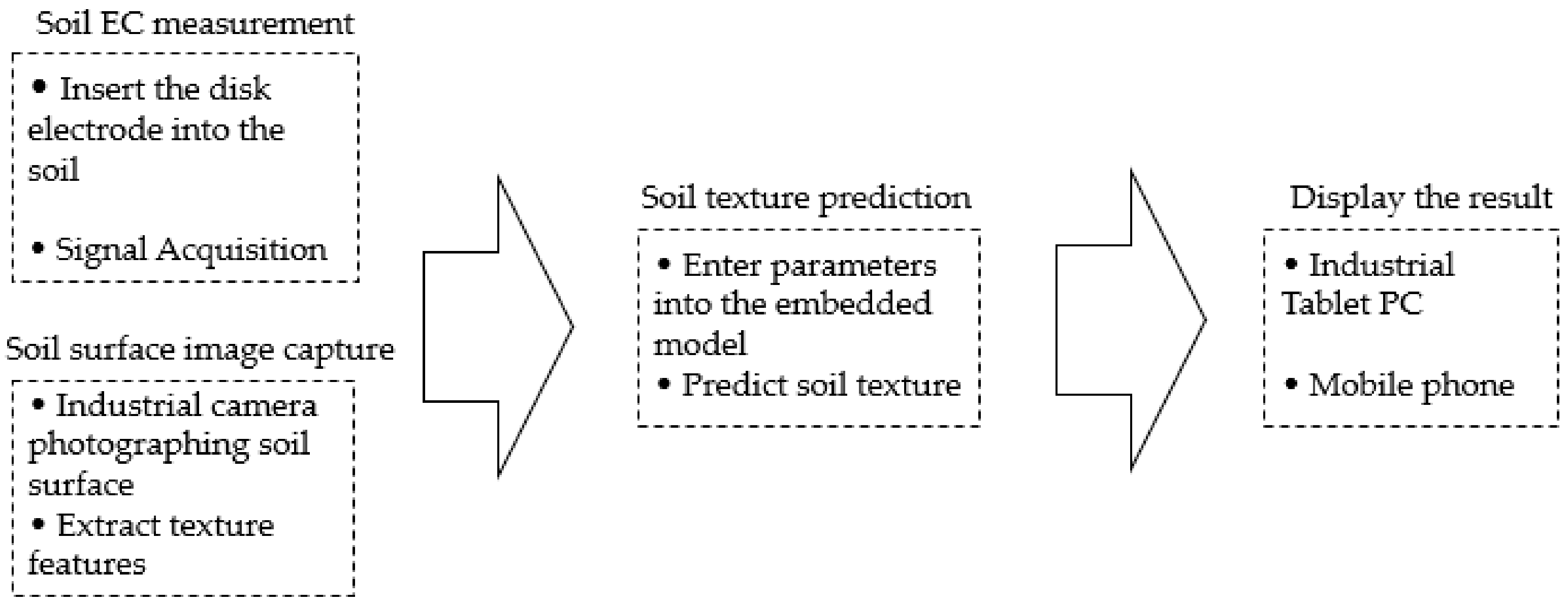
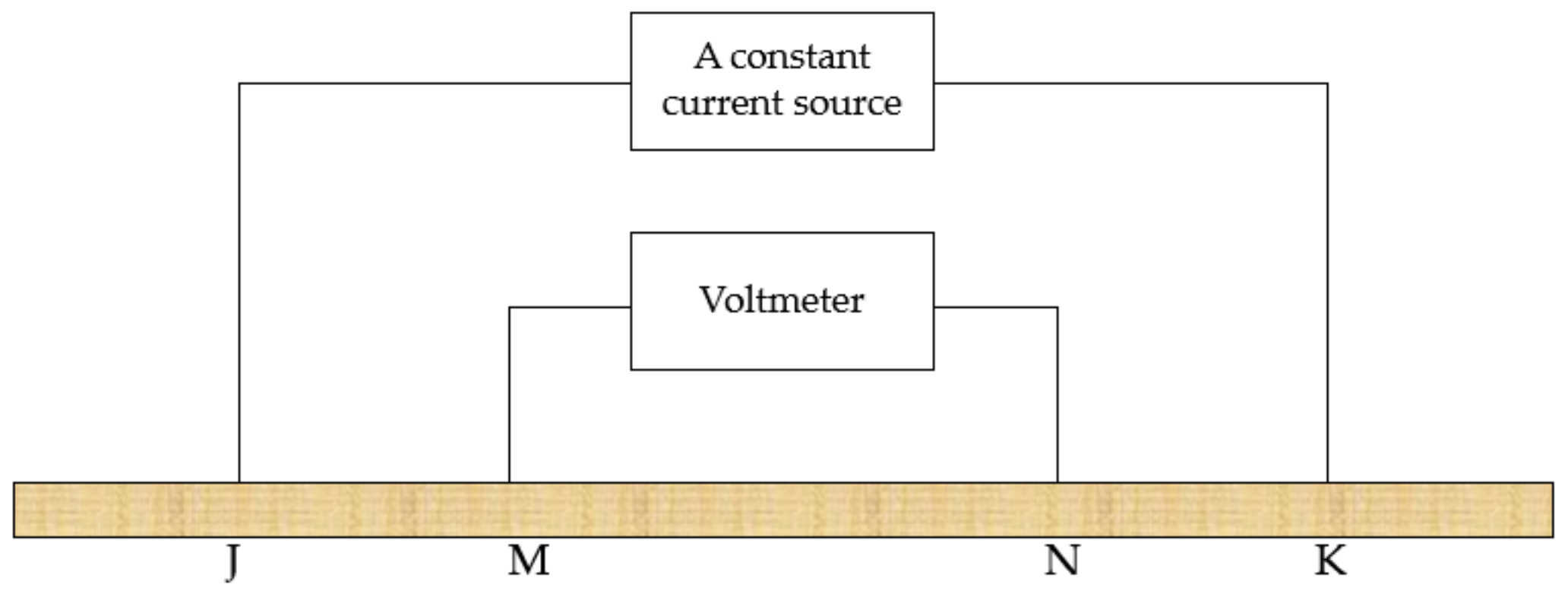


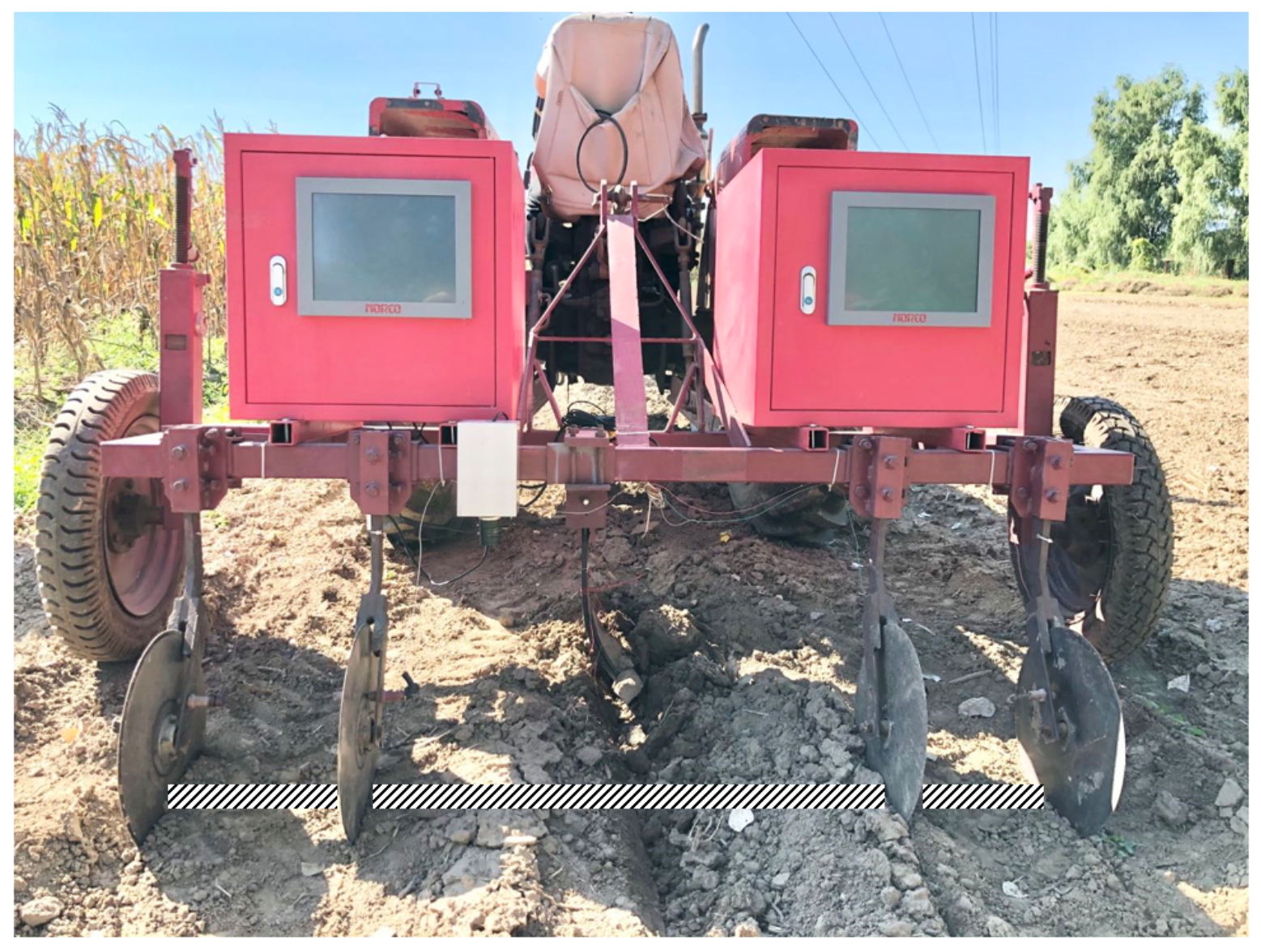
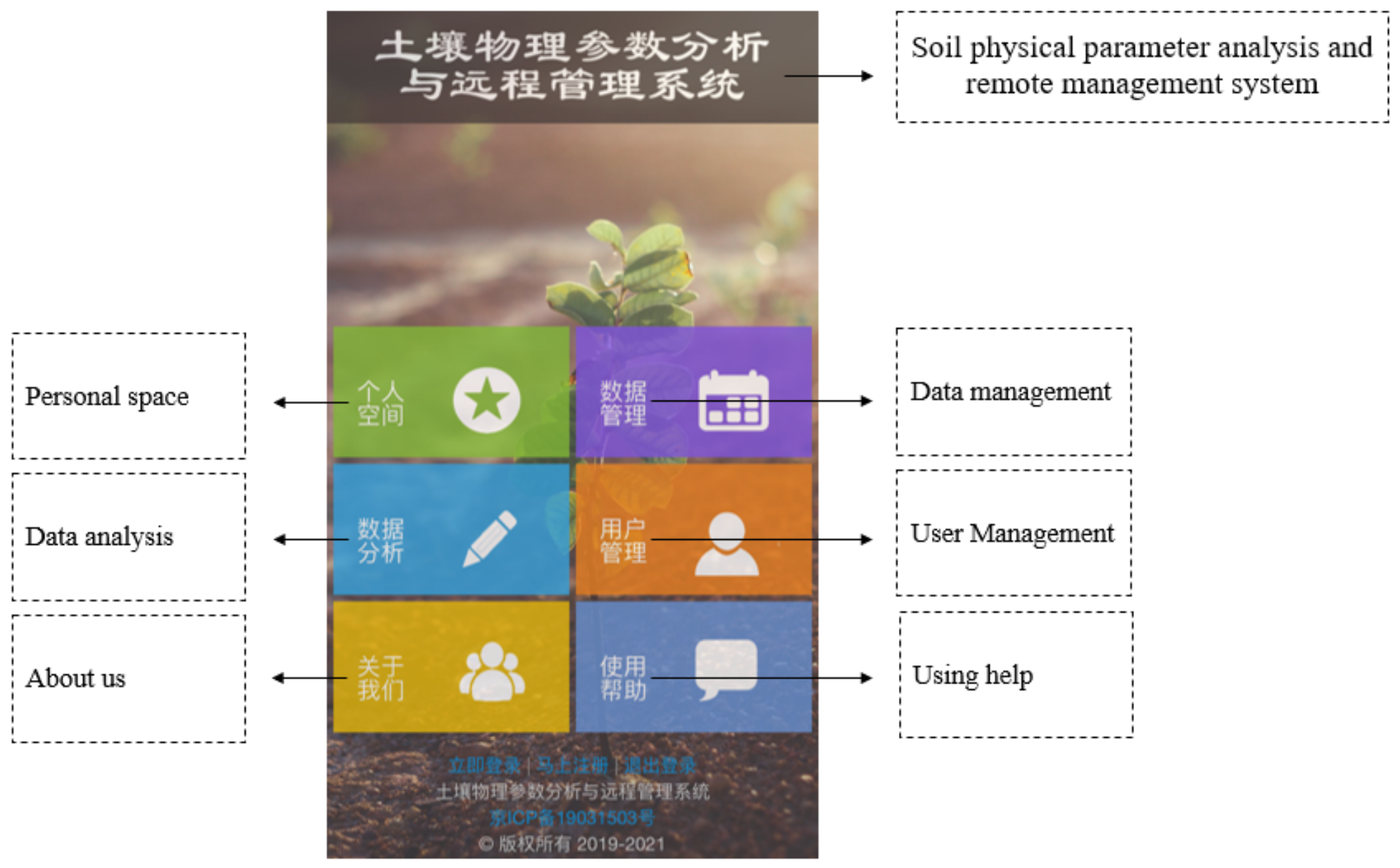
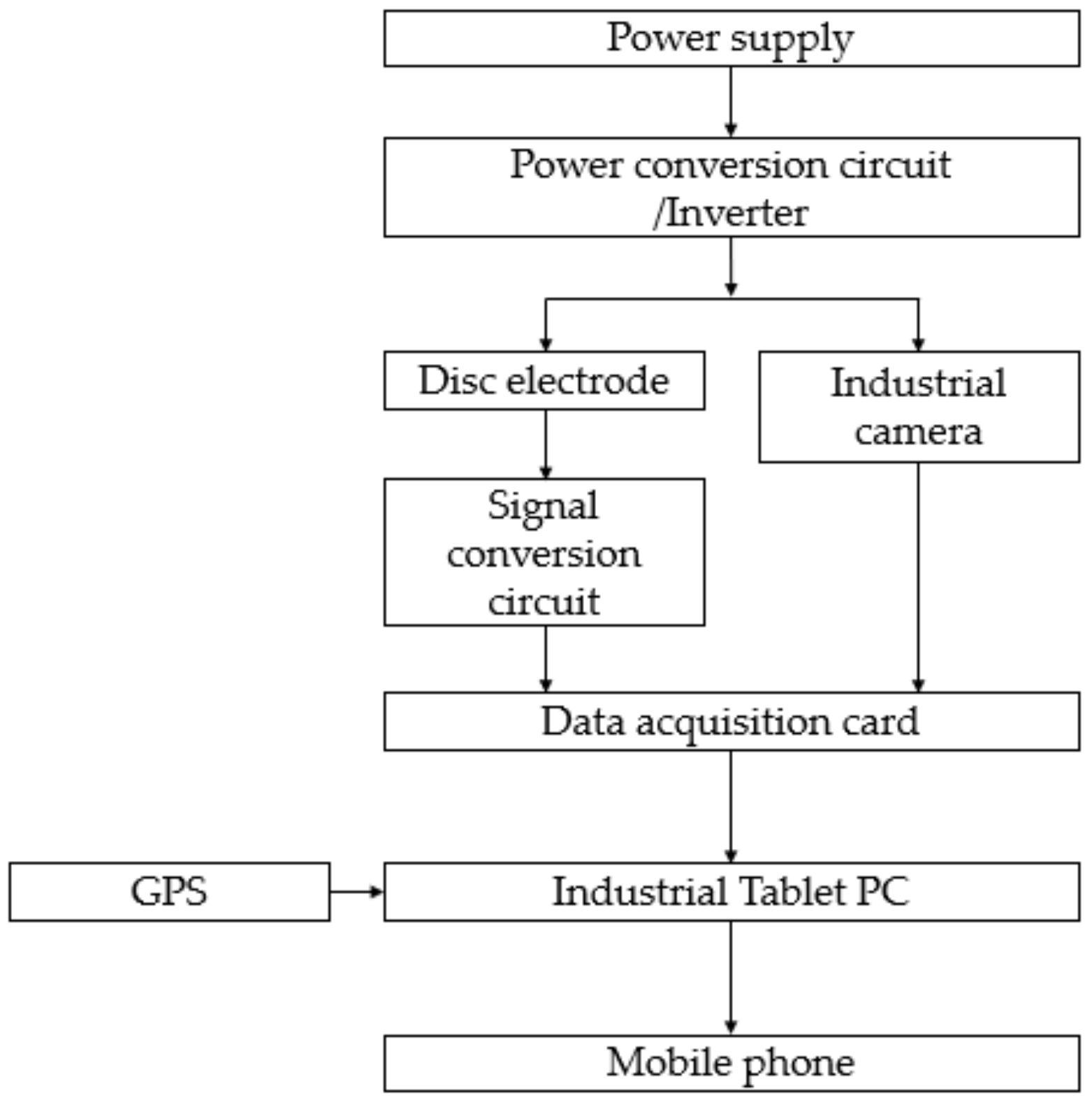

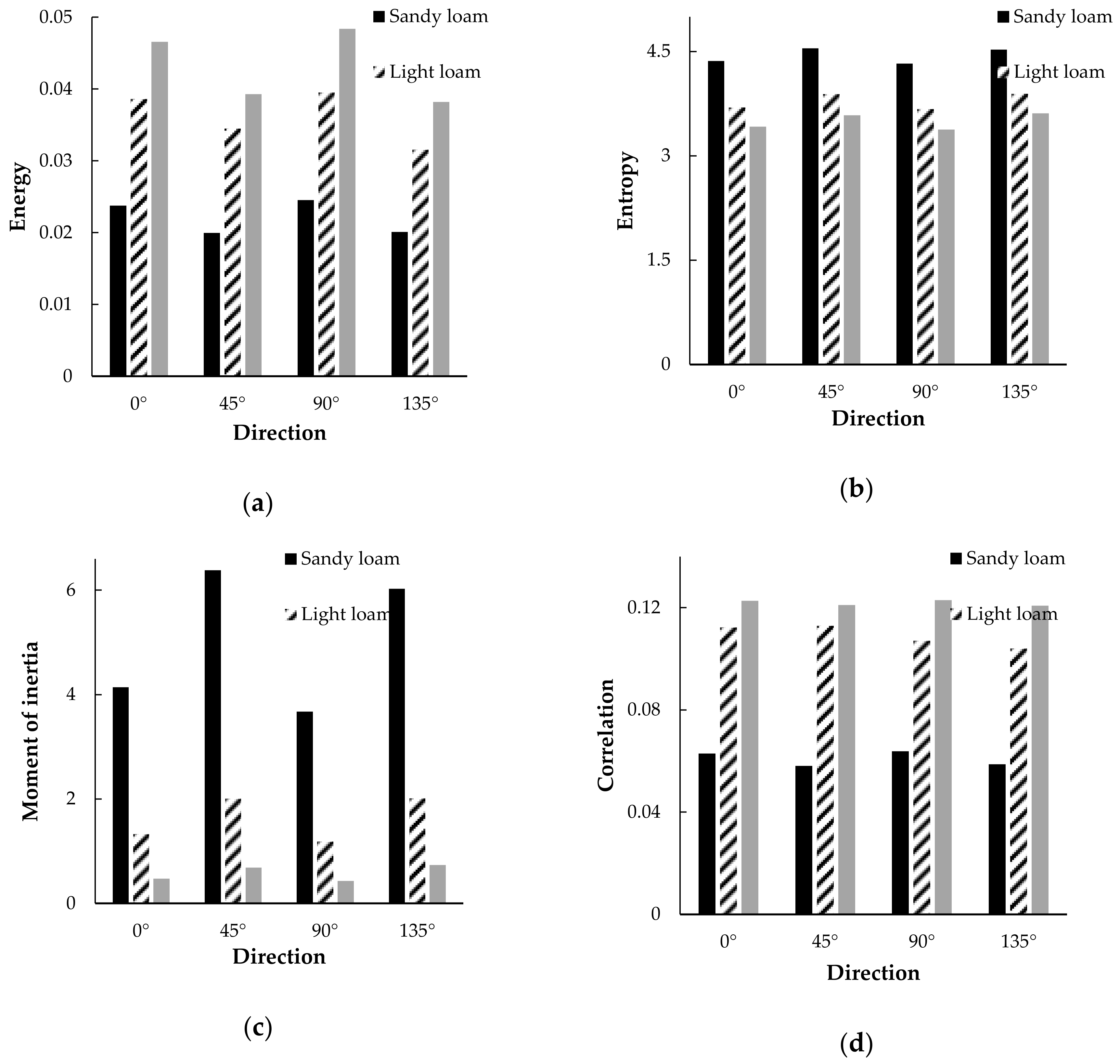
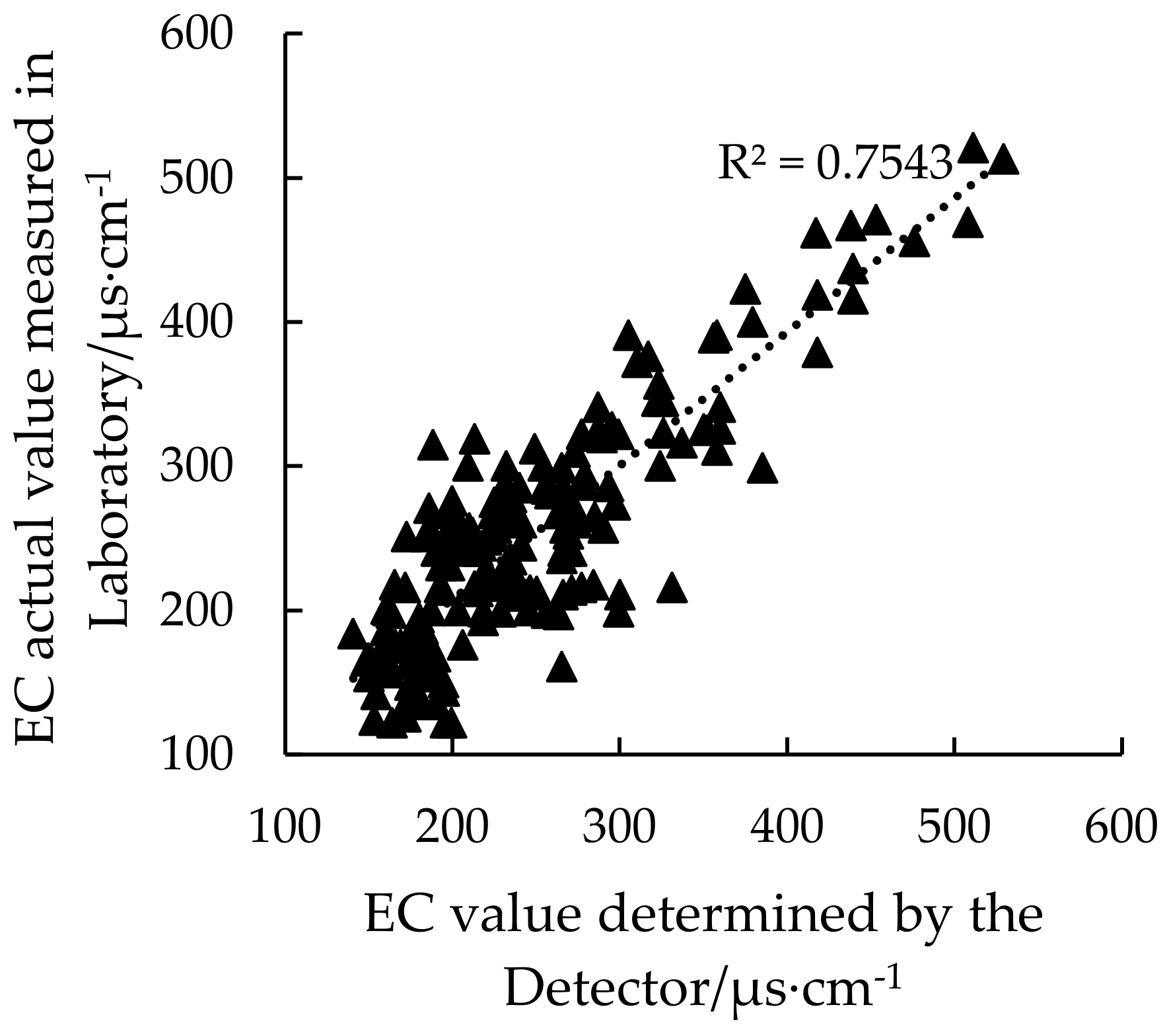
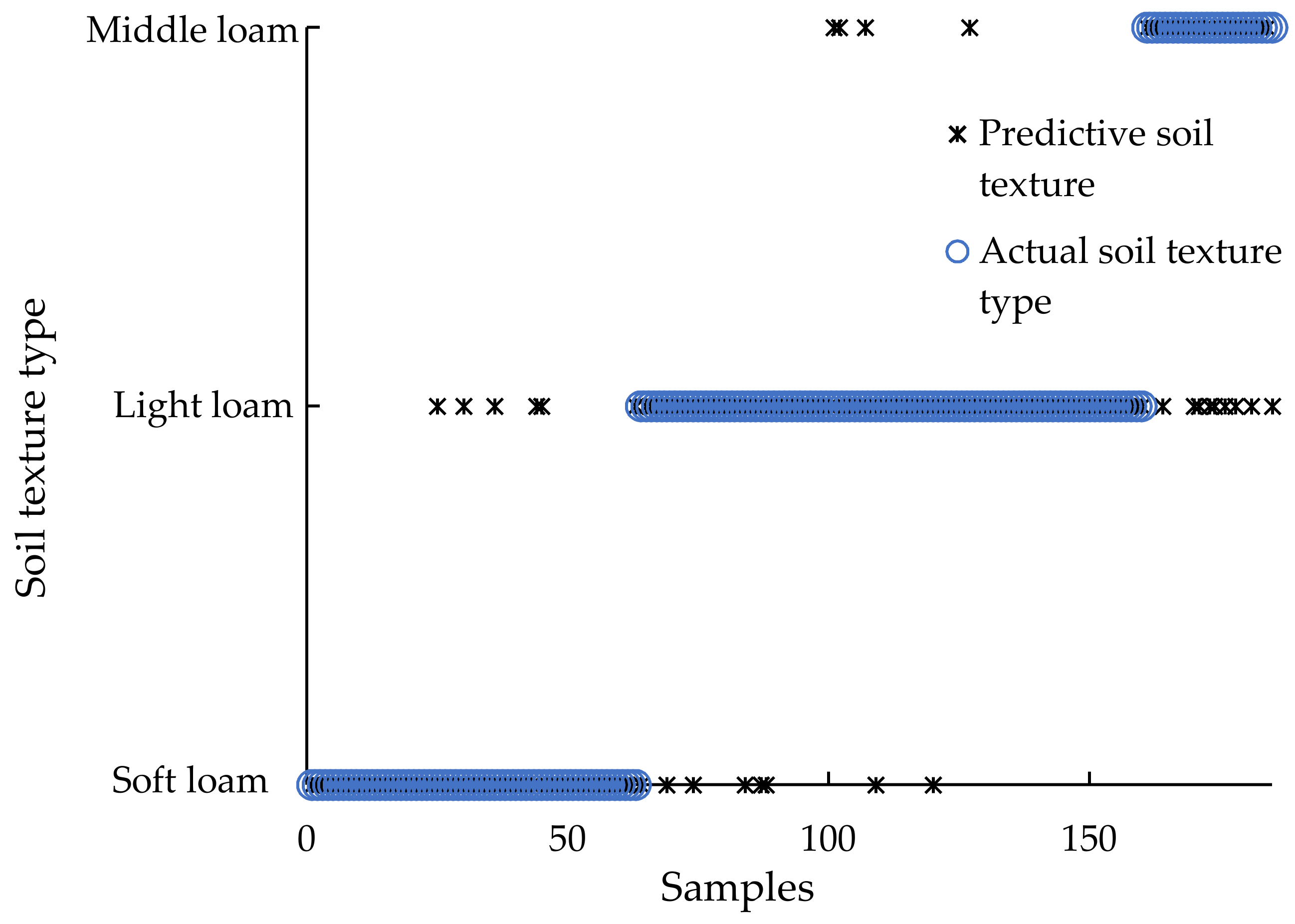
| Soil Texture | Physical Clay (<0.01 mm) Content | Physical Clay (>0.01 mm) Content | |||||
|---|---|---|---|---|---|---|---|
| Podzol | Grassland Soil, Red and Yellow Soil | Columnar Alkaline Soil, Strong Alkaline Soil | Podzol | Grassland Soil, Red and Yellow Soil | Columnar Alkaline Soil, Strong Alkaline Soil | ||
| Sand | Loose sand | 0–5 | 0–5 | 0–5 | 100–95 | 100–95 | 100–90 |
| Tight sand | 5–10 | 5–10 | 5–10 | 95–90 | 95–90 | 95–90 | |
| Loam | Sandy loam | 10–20 | 10–20 | 10–15 | 90–80 | 90–80 | 90–85 |
| Light loam | 20–30 | 20–30 | 15–20 | 80–70 | 80–70 | 85–80 | |
| Middle loam | 30–40 | 30–45 | 20–30 | 70–60 | 70–55 | 80–70 | |
| Heavy loam | 40–50 | 45–60 | 30–40 | 60–50 | 55–40 | 70–60 | |
| Clay | Light clay | 50–65 | 60–75 | 40–50 | 50–30 | 40–25 | 60–50 |
| Medium clay | 65–80 | 75–85 | 50–65 | 35–20 | 25–15 | 50–35 | |
| Heavy clay | >80 | >85 | >65 | <20 | <15 | <35 | |
| Texture | GLCM and EC | Mean | Standard Error | Median | Standard Deviation | Kurtosis | Skewness |
|---|---|---|---|---|---|---|---|
| Sandy loam | Energy | 0.0221 | 0.0021 | 0.0190 | 0.0159 | 5.7348 | 2.3370 |
| Entropy | 4.4408 | 0.0602 | 4.5656 | 0.4662 | 2.6134 | −1.6601 | |
| M of I | 5.0549 | 0.3172 | 5.8599 | 2.4570 | −0.8623 | −0.4730 | |
| Correlation | 0.0609 | 0.0039 | 0.0522 | 0.0301 | 28.9858 | 4.9598 | |
| EC | 271.665 | 8.9177 | 257.000 | 69.0765 | 0.3877 | 0.9216 | |
| Light loam | Energy | 0.0360 | 0.0021 | 0.0326 | 0.0202 | 17.2707 | 2.7564 |
| Entropy | 3.7861 | 0.0490 | 3.6955 | 0.4800 | −0.0321 | 0.6633 | |
| M of I | 1.6319 | 0.2023 | 0.7209 | 1.9823 | 2.8862 | 2.0293 | |
| Correlation | 0.1091 | 0.0067 | 0.0966 | 0.0652 | 20.0478 | 3.0386 | |
| EC | 225.0635 | 6.3721 | 201.500 | 62.4339 | 1.5693 | 1.2774 | |
| Middle loam | Energy | 0.0431 | 0.0029 | 0.0376 | 0.0145 | −0.1002 | 0.7838 |
| Entropy | 3.4965 | 0.0556 | 3.5691 | 0.2779 | −1.1965 | −0.2736 | |
| M of I | 0.5814 | 0.0411 | 0.5107 | 0.2053 | −1.4442 | 0.3729 | |
| Correlation | 0.1219 | 0.0096 | 0.1046 | 0.0479 | 1.5727 | 1.3814 | |
| EC | 218.784 | 11.676 | 199.300 | 58.3801 | 1.3856 | 1.2557 |
| Input | Predicted Soil Texture | |||||
|---|---|---|---|---|---|---|
| Sandy Loam | Light Loam | Middle Loam | Correct Rate | |||
| Actual soil texture | Sandy loam | 32 | 31 | 0 | 50.79% | |
| EC | Light loam | 25 | 72 | 0 | 74.23% | |
| Middle loam | 4 | 17 | 4 | 16% | ||
| Total correct rate | - | - | - | - | 56.21% | |
| Actual soil texture | Sandy loam | 52 | 10 | 1 | 82.59% | |
| GLCM | Light loam | 11 | 85 | 1 | 87.63% | |
| Middle loam | 0 | 15 | 10 | 40% | ||
| Total correct rate | - | - | - | - | 78.38% | |
| Actual soil texture | Sandy loam | 56 | 7 | 0 | 88.89% | |
| EC and GLCM | Light loam | 8 | 85 | 4 | 87.63% | |
| Middle loam | 0 | 9 | 16 | 64% | ||
| Total correct rate | - | - | - | - | 84.86% | |
Publisher’s Note: MDPI stays neutral with regard to jurisdictional claims in published maps and institutional affiliations. |
© 2020 by the authors. Licensee MDPI, Basel, Switzerland. This article is an open access article distributed under the terms and conditions of the Creative Commons Attribution (CC BY) license (http://creativecommons.org/licenses/by/4.0/).
Share and Cite
Meng, C.; Yang, W.; Lan, H.; Ren, X.; Li, M. Development and Application of a Vehicle-Mounted Soil Texture Detector. Sensors 2020, 20, 7175. https://doi.org/10.3390/s20247175
Meng C, Yang W, Lan H, Ren X, Li M. Development and Application of a Vehicle-Mounted Soil Texture Detector. Sensors. 2020; 20(24):7175. https://doi.org/10.3390/s20247175
Chicago/Turabian StyleMeng, Chao, Wei Yang, Hong Lan, Xinjian Ren, and Minzan Li. 2020. "Development and Application of a Vehicle-Mounted Soil Texture Detector" Sensors 20, no. 24: 7175. https://doi.org/10.3390/s20247175
APA StyleMeng, C., Yang, W., Lan, H., Ren, X., & Li, M. (2020). Development and Application of a Vehicle-Mounted Soil Texture Detector. Sensors, 20(24), 7175. https://doi.org/10.3390/s20247175





